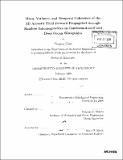| dc.contributor.advisor | Nicholas C. Makris. | en_US |
| dc.contributor.author | Chen, Tianrun | en_US |
| dc.contributor.other | Massachusetts Institute of Technology. Dept. of Mechanical Engineering. | en_US |
| dc.date.accessioned | 2009-08-26T17:05:20Z | |
| dc.date.available | 2009-08-26T17:05:20Z | |
| dc.date.copyright | 2002 | en_US |
| dc.date.issued | 2009 | en_US |
| dc.identifier.uri | http://hdl.handle.net/1721.1/46621 | |
| dc.description | Thesis (Ph. D.)--Massachusetts Institute of Technology, Dept. of Mechanical Engineering, 2009. | en_US |
| dc.description | Includes bibliographical references (p. 165-175). | en_US |
| dc.description.abstract | When an acoustic field propagates through a multimodal waveguide, the effect of variations in medium properties induced by 3D random inhomogeneities accumulates by multiple forward scattering over range. This causes significant random fluctuations in the received field and greatly affects underwater acoustic sensing and communication systems, such as Ocean Acoustic Waveguide Remote Sensing(OAWRS). In order to characterize this effect, analytical expressions are derived for the mean, variance and temporal covariance of the acoustic field forward propagated through an ocean waveguide containing internal waves, fish shoals, wind-generated bubble clouds and krill. These expressions account for the accumulated effects of multiple forward scattering through temporally and spatially varying scatter function densities of the 3D inhomogeneities. In order to quantify the statistics of the scatter function densities, physical models and statistical descriptions of these inhomogeneities are developed.Acoustic field transmission through internal waves in both continental shelf and deep ocean waveguides is investigated. Stratified ocean models are used to describe physical and statistical internal waves properties. Simulations for a typical continental-shelf environment show that when the standard deviation of the internal wave displacement exceeds the acoustic wavelength, the acoustic forward field becomes so randomized that the expected total intensity is dominated by the variance field and lacks a the coherent interference structure beyond moderate ranges. This leads to an effectively saturated field that decays monotonically. It is found that 3D scattering effects become pronounced when the acoustic Fresnel width exceeds the cross-range coherence length of the internal waves. This leads to frequency and range-dependent power losses in the forward field that explains some of the attenuation observed in acoustic transmission through typical continental shelf and deep ocean waveguides. | en_US |
| dc.description.abstract | (cont.) A general analytical expression is derived for the temporal coherence of an acoustic signal propagating through an ocean waveguide with random 3D inhomogeneities.Advance knowledge of this coherence time scale is often essential in the design of ocean acoustic experiments and subsequent data analysis. This is because it determines the number of fluctuations in a given measurement period and the time window within which the coherent processing techniques essential to ocean acoustic data reduction and analysis can be applied. The analytic approach is found to explain the time scale of acoustic field fluctuations observed both at mega meters ranges in the deep ocean, as well as at kilometer ranges in continental shelf environments. The acoustic time scale is found to be much shorter than the coherence time scale of ocean internal waves. This is shown to be a consequence of multiple forward scattering of the acoustic waves through the internal waves. Analytical expressions are derived for the attenuation and dispersion of the acoustic field forward propagated through fish shoals and wind-generated bubble clouds in an ocean waveguide. It is found that at swim bladder resonance, fish shoals may sometimes lead to measurable attenuation in the forward field. The attenuation at off-resonant OAWRS frequencies, however, is typically negligible as shown both by the present theory and experimental data. The modeled attenuation due to random wind-generated bubble clouds is found to be highly sensitive to the choice of cutoff radius, which determines whether resonant bubbles are included in the bubble spectra. It is also found that bubble clouds generated under high wind speeds lead to additional dispersion and attention of the transmitted signal. These expected distortions can significantly degrade standard coherent processing techniques in ocean acoustics, such as the match filter, if not taken into account. | en_US |
| dc.description.abstract | (cont.) Antarctic krill play a key role in the marine food chain as the primary source of sustenance for many species of whales, seals, birds, squid and fish. This makes knowledge of the distribution and abundance of krill essential to ecological research in the southern oceans. It is shown that swarms of Antarctic krill with typical packing densities can be instantaneously imaged by OAWRS over thousands of square kilometers in both deep and shallow water environments given properly designed experiments. | en_US |
| dc.description.statementofresponsibility | by Tianrun Chen. | en_US |
| dc.format.extent | 175 p. | en_US |
| dc.language.iso | eng | en_US |
| dc.publisher | Massachusetts Institute of Technology | en_US |
| dc.rights | M.I.T. theses are protected by
copyright. They may be viewed from this source for any purpose, but
reproduction or distribution in any format is prohibited without written
permission. See provided URL for inquiries about permission. | en_US |
| dc.rights.uri | http://dspace.mit.edu/handle/1721.1/7582 | en_US |
| dc.subject | Mechanical Engineering. | en_US |
| dc.title | Mean, variance, and temporal coherence of the 3D acoustic field forward propagated through random inhomogeneities in continental-shelf and deep ocean waveguides | en_US |
| dc.type | Thesis | en_US |
| dc.description.degree | Ph.D. | en_US |
| dc.contributor.department | Massachusetts Institute of Technology. Department of Mechanical Engineering | |
| dc.identifier.oclc | 426046088 | en_US |
